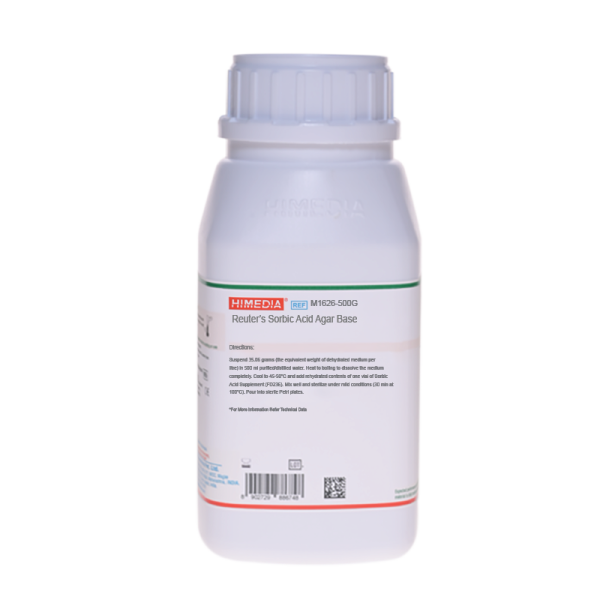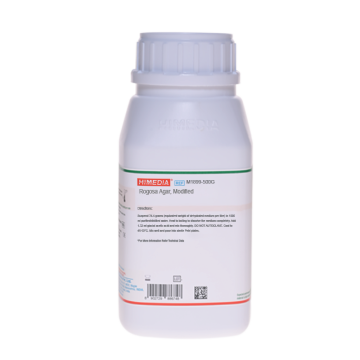 Your enquiry has been submitted
Your enquiry has been submitted
Reuter’s Sorbic Acid Agar Base
Intended Use
Recommended for the isolation and differentiation of Lactobacilli from foodstuffs, faeces etc.
Composition**
| Ingredients | g / L |
|---|---|
| Tryptone | 10.000 |
| HM extract # | 10.000 |
| Yeast extract | 5.000 |
| D-Glucose | 20.000 |
| Sodium acetate | 5.000 |
| Sodium citrate | 3.000 |
| Polysorbate 80 (Tween 80) | 1.000 |
| Magnesium sulphate heptahydrate | 0.200 |
| Manganese sulphate heptahydrate | 0.050 |
| Agar | 16.000 |
Final pH ( at 25°C): 5.0±0.1
**Formula adjusted, standardized to suit performance parameters
# Equivalent to Meat extract
Directions
Suspend 35.06 grams of dehydrated medium in 500 ml distilled water. Heat to boiling to dissolve the medium completely. Cool to 45-50°C and aseptically add rehydrated contents of 1 vial of Sorbic Acid Supplement (FD236). Mix well and sterilize under mild conditions (30 minutes at 100°C). Mix well and pour into sterile Petri plates.
Principle And Interpretation
Lactobacillus is a genus of gram-positive facultative anaerobic bacteria. They are a major part of the Lactic acid bacteria group, named as such, because most of its members convert lactose and other sugars to lactic acid. In humans they are present in the vagina and the gastrointestinal tract, where they are symbiotic and make up a large portion of the gut flora. Some Lactobacillus species are used industrially for the production of yoghurt, sauerkraut, pickles, and other fermented foods, such as silage. Reuters Sorbic Acid Agar Base, described by Reuter (1,2) complies with German recommendations for food examination (3). The growth of Lactobacilli and Staphylococci is favoured by the broad spectrum of nutrients and by magnesium and manganese salts. Sorbic acid suppresses undesired accompanying bacteria (4,5). Enterococci, Pediococci and Leuconostoc grow to form microcolonies.
Type of specimen
Clinical samples - faeces; Dairy samples
Specimen Collection and Handling
For clinical samples follow appropriate techniques for handling specimens as per established guidelines (6,7). For dairy samples, follow appropriate techniques for sample collection and processing as per guidelines (8,9). After use, contaminated materials must be sterilized by autoclaving before discarding.
Warning and Precautions
In Vitro diagnostic Use. For professional use only. Read the label before opening the container. Wear protective gloves/protective clothing/eye protection/face protection. Follow good microbiological lab practices while handling specimens and culture. Standard precautions as per established guidelines should be followed while handling clinical specimens. Safety guidelines may be referred in individual safety data sheets.
Limitations
- Individual organisms differ in their growth requirement and may show variable growth patterns on the medium.
- Each lot of the medium has been tested for the organisms specified on the COA. It is recommended to users to validate the medium for any specific microorganism other than mentioned in the COA based on the user’s unique requirement.
Performance and Evaluation
Performance of the medium is expected when used as per the direction on the label within the expiry period when stored at recommended temperature.
Quality Control
Appearance: Cream to yellow homogeneous free flowing powder
Gelling: Firm, comparable with 1.6% Agar gel
Colour and Clarity of prepared medium: Dark amber coloured clear to slightly opalescent gel forms in Petri plates
Reaction: Reaction of 7.0% w/v aqueous solution at 25°C. pH : 5.0±0.1
pH: 4.90-5.10
Cultural Response
Cultural characteristics observed with added Sorbic Acid Supplement (FD236) under anaerobic condition or in 10% CO2 atmosphere, after an incubation at 35-37°C for 18-48 hours.
| Organism | Inoculum (CFU) | Growth | Recovery |
|---|---|---|---|
| Lactobacillus acidophilus ATCC 4356 (00098*) | 50-100 | good | 40-50% |
| Lactobacillus casei ATCC 9595 | 50-100 | good | 40-50% |
| Lactobacillus fermentum ATCC 9338 | 50-100 | good | 40-50% |
| Lactobacillus plantarum ATCC 8014 | 50-100 | good | 40-50% |
| Staphylococcus aureus subsp. aureus ATCC 25923 (00034*) | >=104 | inhibited | 0% |
| Pseudomonas aeruginosa ATCC 27853 (00025*) | >=104 | inhibited | 0% |
| Leuconostoc mesenteroides ATCC 9135 | 50-100 | fair | 20-30% |
Key : *Corresponding WDCM numbers.
Storage and Shelf Life
Store between 10-30°C in a tightly closed container and the prepared medium at 2-8°C. Use before expiry date on the label. On opening, product should be properly stored dry, after tightly capping the bottle in order to prevent lump formation due to the hygroscopic nature of the product. Improper storage of the product may lead to lump formation. Store in dry ventilated area protected from extremes of temperature and sources of ignition. Seal the container tightly after use. Product performance is best if used within stated expiry period.
Disposal
User must ensure safe disposal by autoclaving and/or incineration of used or unusable preparations of this product. Follow established laboratory procedures in disposing of infectious materials and material that comes into contact with clinical sample must be decontaminated and disposed of in accordance with current laboratory techniques (5,6).
Reference
- Reuter G., 1968, Arch.f. Lebensmittelhyg., 19; 53-57 und 84-89
- Reuter G., 1970, Fleischwirtsch., 954-962.
- Bundesgesundheitsamt, Amtliche Sammlung von Untersuchungsverfahren nach § 35 LMBG. (06.00/31), June 1992, Beuth-Verlag: Berlin, Koln.
- Emard L. O., Vaughn R. H.,1952, J. Bacteriol., 63:487-494.
- Haenel H., Mueller-Beuthow W., 1957, Zbl. Bakt. I. Orig., 169;196-204.
- Isenberg, H.D. Clinical Microbiology Procedures Handbook 2nd Edition.
- Jorgensen, J.H., Pfaller, M.A., Carroll, K.C., Funke, G., Landry, M.L., Richter, S.S and Warnock., D.W. (2015) Manual of Clinical Microbiology, 11th Edition. Vol. 1.
- American Public Health Association, Standard Methods for the Examination of Dairy Products, 1978, 14th Ed., Washington D.C.
- Wehr H. M. and Frank J. H., 2004, Standard Methods for the Microbiological Examination of Dairy Products, 17th Ed.,APHA Inc., Washington, D.C.
| Product Name | Reuter’s Sorbic Acid Agar Base |
|---|---|
| SKU | M1626 |
| Product Type | Regular |
| Physical Form | Powder |
| Origin | Animal |
| Packaging type | HDPE |
| References | 1. Reuter G., 1968, Arch.f. Lebensmittelhyg., 19; 53-57 und 84-89 |
| Customized Product Available | No |








